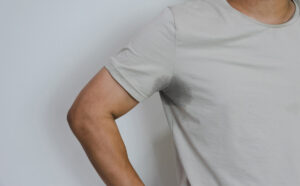Table of Contents
The Federal Drug Administration (FDA) recently approved a prescription-only drug designed to treat axillary hyperhidrosis (excessive armpit sweating). This hyperhirosis medicine is called Qbrexza (or Qbrexza Cloth), and it is manufactured by Dermira.
New hyperhidrosis treatments are encouraging and welcome. Let’s look at this newly approved treatment and it’s application(s) and potential side effects.
What Should Know Before Trying Qbrexza:
- What is Qbrexza?
- How does Qbrexza work? How does it reduce sweating?
- How to use Qbrexza
- Who should use Qbrexza?
- Why is Qbrexza only available by prescription?
- What is the difference between Qbrexza’s ingredients and clinical-strength antiperspirants like SweatBlock?
- How is Qbrexza different from other Anticholinergic drugs (focused topical treatment vs generalized oral treatment)?
- What are the side effects of Qbrexza?
- Qbrexza risks and warnings
- Where can you purchase Qbrexza?
- Who makes Qbrexza and what do I need to know about Dermira
- Are there Qbrexza alternatives?
Over 15 million in the United States suffer from excessive sweating ( hyperhidrosis ). Many of these people suffer in silence. And fewer than 40% ever seek help for their excessive perspiration.
☝️ Wondering why you might be sweating more than normal?
Here are 12 possible reasons people sweat so much.
Hyperhidrosis is normally not life-threatening, but it can l be profoundly life-altering. People who suffer from extreme cases of excessive sweating find that it reeks havoc on the social, emotional and occupational facets of their lives. It turns outgoing social butterflies into a cave-dwelling introverts who may feel like lighting a candle and waiting until it’s all over.
There are many treatments available for axillary hyperhidrosis (excessive underarm sweating). The newest is Qbrexza Cloth. Qbrexza Cloth is a prescription drug specifically designed for topical use on the underarm area. If you sweat excessively, you might consider making a trip to your doctor to see if you are a potential candidate.
This guide is designed to answer your questions about Qbrexza: how it works and what side effects can be expected and even anticipated. What follows will help you make an informed decision.
What is Qbrexza?
Qbrexza is a medicated wipe or towelette that is topically applied to the underarms to reduce excessive armpit sweating. Available only by prescription, it is a topically applied anticholinergic medicine for the treatment of primary axillary hyperhidrosis (extreme focal sweating).
How does Qbrexza work? How does it reduce sweating?
Qbrexza contains an anticholinergic drug called glycopyrronium. Anticholinergic drugs prevent your body’s nervous system from communicating with certain other cells. In this instance, the glycopyrronium blocks your body from activating your sweat glands. As an analogy, imagine cutting the cable on your computer’s wired keyboard. Whatever you type on the keyboard will be blocked from getting to the computer because of the broken connection. That’s how Qbrexza works.
How to Use Qbrexza
The Qbrexza cloth is applied by swabbing the affected underarm area every 24 hours with a saturated wipe. If effective as intended, the medicated Qbrexza wipe will prevent armpit sweat glands from activating. Because Qbrexza is a powerful prescription drug, your doctor may have additional instructions for its safe use. As with other topical axillary hyperhidrosis treatments, Dermira recommends that Qbrexza be used only on clean, dry skin AND never on broken or irritated skin.
Should you use Qbrexza?
Qbrexza is specifically designed for those who suffer from axillary hyperhidrosis or excessive underarm sweating. As with many prescription drugs, Qbrexza is accompanied with a entourage of potential unwanted side effects and warnings. It should only be considered after you’ve exhausted all other lower-risk treatment options.
You should never use prescription drugs without first consulting your doctor. (And never use a prescription that hasn’t been prescribed for you personally.) Qbrexza’s maker also recommends its use for patients aged 9 and older. Clinical testing on children younger than 9 years is inconclusive. Its safety and effectiveness for young children are unknown.
Why is Qbrexza only available by prescription?
Qbrexza contains the active ingredient glycopyrronium, an anticholinergic drug. This drug has been previously available as an oral medication for treating diseases unrelated to hyperhidrosis. It’s use as a treatment for hyperhidrosis has been “off label” meaning that it was not specifically intended to treat excessive sweating. Neurotransmitter-blocking anticholinergic drugs like glycopyrronium were initially prescribed for the treatment of COPD, asthma, incontinence, and other types of gastrointestinal issues.
Qbrexza is the first topical application of glycopyrronium specifically intended for the treatment of hyperhidrosis. The side effect warnings for applying the drug topically are the same as when the drug is taken by mouth.
What is the difference between Qbrexza’s ingredients and clinical strength antiperspirants?
Clinical strength antiperspirants available over the counter use some form of the active ingredient aluminum chloride. It has proven effective for over 80 years and does not require a doctor’s prescription. Potential side effects of the antiperspirants containing aluminum chloride are minor, localized, and short-lived.
Because Qbrexza uses the active ingredient glycopyrronium, there are potentially very serious warnings and side effects. Other less risk-prone treatments may offer as much efficacy as Qbrexza.
How is Qbrexza different from other Anticholinergic drugs?
As mentioned before, Qbrexza is the only anticholinergic drug currently approved by the FDA specifically for the treatment of hyperhidrosis. Both the oral anticholinergic and the topical anticholinergic in Qbrexza utilize the same drug. Orally administered anticholinergics affect the entire body. The topical formulation applied locally on your armpits is intended to be more focused. Either way the anticholinergic is absorbed into your system. There is a high risk for negative side effects in both the oral and topical treatments.
What are side effects of Qbrexza?
Patients with certain medical conditions should avoid glycopyrronium, both in oral and topically-applied forms, as with Qbrexza Cloth. The use of anticholinergics for these people can have dire health consequences.
These include patients with conditions such as:
- Glaucoma
- Unstable cardiovascular status
- Paralytic ileus
- Ulcerative colitis
- Myasthenia gravis
- Toxic megacolon
- Sjogren’s syndrome
Caution: Dermira recommends that Qbrexza medication should not be used while taking any other anticholinergic drug. There could be a resultant additive effect that will increase the adverse side effects of other anticholinergic medications.
Possible side effects of Qbrexza
The possible side effects of Qbrexza and other anticholinergic drugs include:
Dry mouth. Dry mouth was the most commonly reported side effect in the clinical Qbrexza trials. 24.2% of trial subjects reported dry mouth– a 1 in 4 chance.
Constipation. Because anticholinergic drugs affect the central nervous system, constipation is a frequent side effect. You may need to use a laxative while using Qbrexza.
Urinary retention (trouble peeing). If you have a history of trouble urinating, or if you have difficulty passing urine now, or you have a distended bladder, you should proceed with great caution when considering the use of Qbrexza. If you experience any urinary troubles, tell your doctor. Anyone with bladder neck obstruction or prostatic hypertrophy should exercise extreme caution. When Qbrexza was tested in the clinical trials, people who had a history of any urinary retention problems were excluded from the study.
Blurred vision. in the clinical trials of Qbrexza, mydriasis or dilation of the pupils in the eyes was reported nearly 7% of study participants. This is why it’s dangerous to drive or operate machinery. Be careful and safe. If you experience any vision problems while using Qbrexza, immediately discontinue activity until your vision clears. It will pass. Wait it out.
Head and throat pain. Head and/or throat pain was reported by 5.7% clinical study participants. Dry throat without specific pain was also noted.
Burning and itchy skin. Skin irritations are frequently experienced by users of anticholinergics. Localized skin reactions at the site of the application in the armpits were not uncommon in the Qbrexza clinical trial. These included erythema (redness) by 17.0% of study participants, some burning or stinging sensations by 14.1% of participants and pruritus or severe itching was experienced by 8.1% of those in the study.
Dry skin, mouth, and eyes. Also common side effects from anticholinergic use.
Body temperature control. Qbrexza users will experience reduced sweating. Heat stroke and hyperpyrexia can occur when you don’t sweat enough to cool your body. If you become overheated while minimally sweating or you stop sweating all together, seek out a doctor’s help immediately.
Anticholinergic Syndrome. Anticholinergic syndrome is the result of an overdose of anticholinergic drugs. It can cause central inhibition, which leads to a hyperactive, agitated state of delirium, accompanied by feelings of confusion and restlessness. Poking at imaginary objects is a common symptom of anticholinergic syndrome.
If you’re using Qbrexza or any other anticholinergic drug, be watchful for these tell-tale symptoms:
1. Hot, dry skin with a flushed appearance
2. Dilated pupils in your eyes (mydriasis)
3. Rapid heartbeat (tachycardia)
4. Constipation and decreased bowel sounds
5. Difficulty urinating
Anticholinergic syndrome ranges in severity from mild to life-threatening seizures, coma, and even cardiovascular toxicity.
Qbrexza Risks and Warnings
If you are taking any of the following medications, it is important to talk to your doctor as there could be dangerous drug interactions:
- Antihistamines (cold medicines) such as Cyproheptadine, Chlorpheniramine, Promethazine, Doxylamine, or Diphenhydramine
- An antitussive (cough medicine) like Dextromethorphan
- Tricyclic antidepressants like Doxepin, Amitriptyline (often used for migraines), or Imipramine
- Antipsychotics like Olanzapine, Quetiapine, Haloperidol, Droperidol, or Chlorpromazine
- Anticonvulsants like Carbamazepine
- Antiemetics (travel sickness medicine) like scopolamine (brand name Hyoscine)
- Topical ophthalmoplegics (for optical migraines) such as Homatropine and Cyclopentolate
In addition, contact with certain plants can trigger negative side effects. Be careful using Qbrexza wipes in proximity to any of the family of nightshade plants (also known as Atropa belladonna), mandrake root, jimson weed, lupin beans, and Angel’s Trumpet (also known as Datura).
Other Warnings include…
- Pregnancy. There is currently no available data on the use of Qbrexza medication for pregnant women. It is not possible to determine the potential risk associated with this drug for adverse developmental outcomes for the fetus.
- Lactation (breast feeding) There is currently no data available on the how the presence of glycopyrrolate in human milk may affect an infant or what the effects would be on the mother’s milk production. Developmental benefits of infant breastfeeding should be considered.
- Renal Impairment (kidney disease) The ability to eliminate glycopyrronium will be impaired for any patient with a diagnosis of kidney disease or renal failure.
Qbrexza effectiveness
The long-term clinical studies assessed the safety of using Qbrexza over the period of one year.
When compared to participants who received placebos, the patients dosing with Qbrexza did report significant improvement. The severity of excessive sweating was reduced. The quality of life improved with what was considered to be a mild to moderate range of side effects.
Between 72% and 77% of participants reported a reduction in excessive perspiration. The patients who experienced a reduction in underarm sweating reported at least a 50% reduction in the sweat volume.
Who makes Qbrexza and what should I know about Dermira?
Dermira is the manufacturer of Qbrexza. It is a specialty biopharmaceutical development-stage biotech company. It focuses on the development and commercialization of innovative therapies and differentiated products in dermatology. The company is based in the San Francisco Bay area of California, in Menlo Park.
When will Qbrexza be available?
Dermira made Qbrexza available via prescription in early October of 2018.
Are there Qbrexza alternatives?
For the millions of people that suffer from excessive sweating, there is an entire gamut of hyperhidrosis treatments that have proven safe and effective. Some may provide lasting relief without using an anticholinergic with it’s associated risks and side effects. Qbrexza alternatives include:
Lifestyle remedies including regular bathing, choosing the right clothing and using an underarm antiperspirant or deodorant. There are even special tee shirts that absorb or block sweat.
Clinical strength antiperspirants like SweatBlock. These can safely and effectively stop profuse sweating for up to 7 days with no serious side effects. SweatBlock provides dependable relief for sufferers of all forms of primary hyperhidrosis.
Prescription strength antiperspirants. These have the highest allowable concentration of aluminum chloride (or similar).
Botox injections
Microwave treatments that destroy targeted sweat glands. Painful and effective but expensive.
Iontophoresis. These treatments for excessive sweating of the hands or feet use low voltage electrical current to drive medications, often anticholinergics, through the skin.
Sweat gland removal surgery. A last resort option where sweat glands are permanently removed. Highly invasive and expensive.
Whatever the extent of your sweating problem, there is a viable treatment that can provide relief. Qbrexza is a new, powerful drug that can reduce or eliminate underarm perspiration. But, it’s active ingredient, glycopyrronium, brings with it the high likelihood of unwanted, perhaps even serious, side effects.
Before you go down the road of prescription antiperspirants or hyperhidrosis medications like Qbrexza, try SweatBlock. It’s a strong antiperspirant that doesn’t require prescriptions or come with a long list of scary side effects. Try SweatBlock risk free today.
You might also like...

How to Stop Armpit Sweat – 12 Ways to Keep Underarms Dry
Have you ever hesitated to hug someone, raise your hand, or cheer on your favorite team solely because you didn’t

Top 10 Best Deodorants For Sweaty Armpits
Do you struggle with sweaty armpits? Has your deodorant let you down when it comes to stopping sweat and providing

Is There a Hyperhidrosis Cure? 11 Hyperhidrosis Treatment Options
If you’re one of the roughly 8 million Americans who deal with excessive sweating (also known as hyperhidrosis), this article
















